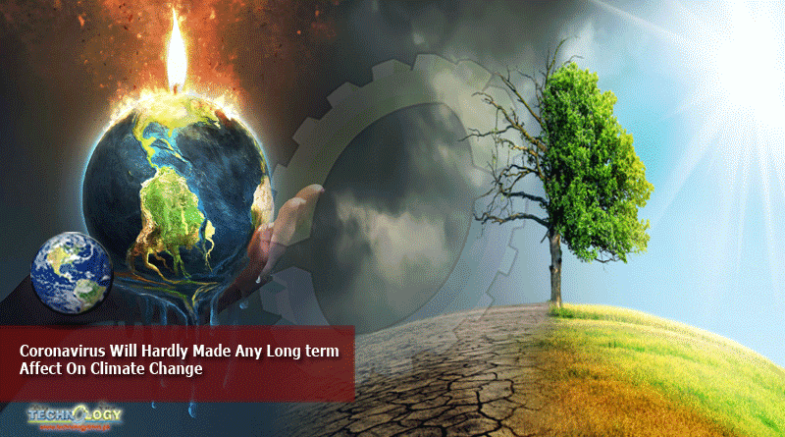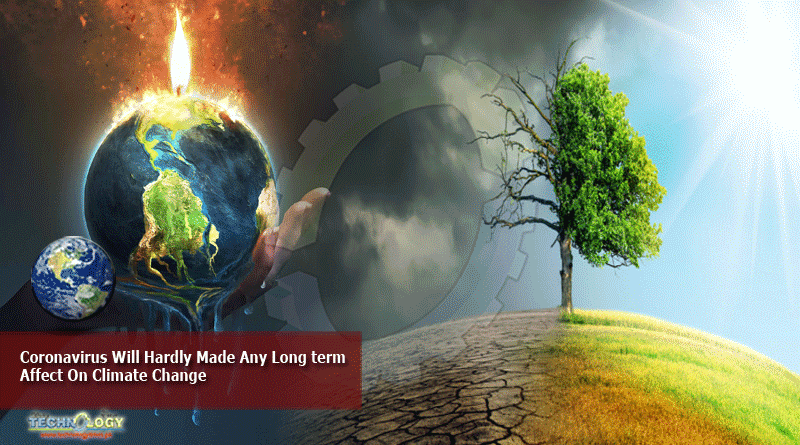Measures to slow the spread of Coronavirus that saw people stay home and use cars less will only have a ‘negligible’ Long term Affect on climate change, study finds.

Long term Affect, Researchers from the University of Leeds examined changes in greenhouse gas and pollutant levels between February and June, 2020 in 123 different countries.
Pollutant levels did drop globally but the impact will only be short-lived, with temperatures only dropping by 0.02F even if lockdown lasted until the end of 2021.
Leeds researchers say that if governments choose a strong green stimulus route out of the pandemic it could halve temperature rises expected by 2050 giving the world a chance to keep increases below the maximum 2.7F goal.
The team’s findings show that carbon dioxide, nitrogen oxides and other emissions fell by between 10-30 per cent globally – but it only had a tiny impact long-term.
If countries choose a ‘strong’ green stimulus route out of the pandemic it could halve the temperature rises expected by 2050, the study authors found.
Keeping global temperature increases to more than 2.7F – as agreed under the Paris agreement – would prevent the most dangerous impacts of global warming.
Recovery packages targeting low-carbon energy and energy efficiency and not giving bailouts for fossil fuels could ‘mean the difference between success and failure’ on avoiding dangerous climate change, the authors say.
Long term Affect, Study lead author Professor Piers Forster, started working on the analysis with his daughter Harriet after her A-levels were cancelled.
They used mobility data from Google and Apple to calculate how 10 different greenhouse gases and pollutants changed between February and June in 123 countries, before a wider team helped with detailed analysis.
Long term Affect, ‘Choices now could give us a strong chance of avoiding 0.3C of additional warming by mid-century, halving the expected warming under current policies,’ said Forster.
‘This could mean the difference between success and failure when it comes to avoiding dangerous climate change.’
He added: ‘The study also highlights the opportunities in lowering traffic pollution by encouraging low emissions vehicles, public transport and cycle lanes.
‘The better air quality will immediately have important health effects – and it will immediately start cooling the climate.’
The team also modelled options for post-lockdown action, ranging from a fossil-fuelled recovery to two different levels of green stimulus.
Emissions of carbon dioxide, nitrogen oxides and other pollutants fell by between 10-30 per cent, the analysis said.
But because the reduction was only temporary, the impact on warming driven by the long-term build up of greenhouse gases in the atmosphere will be very small.
It is what happens now that is important and what measures governments take to help economies recover, the researchers said.
Long term Affect, Dave Reay, an expert in climate change form the University of Edinburgh, said it normally takes years for estimates like this to see the light of day.
‘Through ingenious use of mobility data from Google and Apple (and presumably an awful lot of home-based data crunching by the research team) this study gives the clearest picture yet on how Covid has impacted global emissions.’
Strong action to drive the recovery through green measures could lead to greenhouse gas emissions being 50 per cent lower in 2030 than they would otherwise be, which would reduce expected warming by 0.54F by 2050.
It could set the world on track to keep temperature rises to no more than 2.7F above pre-industrial levels and prevent the worst aspects of global warming.
Beyond that threshold, scientists warn of increased droughts and extreme weather, spread of diseases, reduced crop yields, rising seas and harm to wildlife.
Long term Affect, Study co-author Harriet Forster, who has just completed her studies at Queen Margaret’s School, said the actual effect of lockdown on climate change is small.
‘The important thing to recognise is that we’ve been given a massive opportunity to boost the economy by investing in green industries – and this can make a huge difference to our future climate.’
Long term Affect, Mark Maslin, Professor of Climatology, University College London, who wasn’t involved in the study, said restrictions were too short-lived for long-term impact.
‘The study has a stark warning which is none of this will be possible if governments choose a recovery with fossil fuel stimulus,’ Maslin said.
‘This will make the Paris agreement targets nearly impossible and, as shown by the IEA report earlier this year, will create a slower, dirtier, and unsustainable recovery.’
Pete Smith, Professor of Soils and Global Change at the University of Aberdeen, said all was not lost and this study proves the future is in the hands of governments.
‘The study shows that if we try to reboot the economy by incentivising low-carbon technologies, businesses and jobs, we will have a chance of avoiding the worst excesses of future warming,’ he said.
‘But if we return to pre-COVID business-as-usual, we will have thrown away our best chance of getting the world on track to net zero emissions. We have a small window of opportunity to get this right, and we can’t afford to waste it.’
Carbon dioxide
Carbon dioxide (CO2) is one of the biggest contributors to global warming. After the gas is released into the atmosphere it stays there, making it difficult for heat to escape – and warming up the planet in the process.
It is primarily released from burning fossil fuels such as coal, oil and gas, as well as cement production.
The average monthly concentration of CO2 in the Earth’s atmosphere, as of April 2019, is 413 parts per million (ppm). Before the Industrial Revolution, the concentration was just 280 ppm.
CO2 concentration has fluctuated over the last 800,000 years between 180 to 280ppm, but has been vastly accelerated by pollution caused by humans.
Nitrogen dioxide
The gas nitrogen dioxide (NO2) comes from burning fossil fuels, car exhaust emissions and the use of nitrogen-based fertilisers used in agriculture.
Although there is far less NO2 in the atmosphere than CO2, it is between 200 and 300 times more effective at trapping heat.
Sulfur dioxide
Sulfur dioxide (SO2) also primarily comes from fossil fuel burning, but can also be released from car exhausts.
SO2 can react with water, oxygen and other chemicals in the atmosphere to cause acid rain.
Carbon monoxide
Carbon monoxide (CO) is an indirect greenhouse gas as it reacts with hydroxyl radicals, removing them. Hydroxyl radicals reduce the lifetime of carbon dioxide and other greenhouse gases
What is particulate matter?
Particulate matter refers to tiny parts of solids or liquid materials in the air.
Some are visible, such as dust, whereas others cannot be seen by the naked eye.
Materials such as metals, microplastics, soil and chemicals can be in particulate matter.
Particulate matter (or PM) is described in micrometres. The two main ones mentioned in reports and studies are PM10 (less than 10 micrometres) and PM2.5 (less than 2.5 micrometres).
Particulate matter is sent into the air by a number of processes including burning fossil fuels, driving cars and steel making.
Why are particulates dangerous?
Particulates are dangerous because those less than 10 micrometres in diameter can get deep into your lungs, or even pass into your bloodstream. Particulates are found in higher concentrations in urban areas, particularly along main roads.
What sort of health problems can pollution cause?
According to the World Health Organization, a third of deaths from stroke, lung cancer and heart disease can be linked to air pollution.
Some of the effects of air pollution on the body are not understood, but pollution may increase inflammation which narrows the arteries leading to heart attacks or strokes.
As well as this, almost one in 10 lung cancer cases in the UK are caused by air pollution.
Particulates find their way into the lungs and get lodged there, causing inflammation and damage. As well as this, some chemicals in particulates that make their way into the body can cause cancer.
Deaths from pollution
Around seven million people die prematurely because of air pollution every year. Pollution can cause a number of issues including asthma attacks, strokes, various cancers and cardiovascular problems.
Asthma triggers
Air pollution can cause problems for asthma sufferers for a number of reasons. Pollutants in traffic fumes can irritate the airways, and particulates can get into your lungs and throat and make these areas inflamed.
Problems in pregnancy
Women exposed to air pollution before getting pregnant are nearly 20 per cent more likely to have babies with birth defects, research suggested in January 2018.
Living within 3.1 miles (5km) of a highly-polluted area one month before conceiving makes women more likely to give birth to babies with defects such as cleft palates or lips, a study by University of Cincinnati found.
For every 0.01mg/m3 increase in fine air particles, birth defects rise by 19 per cent, the research adds.
Previous research suggests this causes birth defects as a result of women suffering inflammation and ‘internal stress’.
What is being done to tackle air pollution?
Paris agreement on climate change
The Paris Agreement, which was first signed in 2015, is an international agreement to control and limit climate change.
It hopes to hold the increase in the global average temperature to below 2°C (3.6ºF) ‘and to pursue efforts to limit the temperature increase to 1.5°C (2.7°F)’.
Carbon neutral by 2050
The UK government has announced plans to make the country carbon neutral by 2050.
They plan to do this by planting more trees and by installing ‘carbon capture’ technology at the source of the pollution.
Some critics are worried that this first option will be used by the government to export its carbon offsetting to other countries.
International carbon credits let nations continue emitting carbon while paying for trees to be planted elsewhere, balancing out their emissions.
No new petrol or diesel vehicles by 2040
In 2017, the UK government announced the sale of new petrol and diesel cars would be banned by 2040.
From around 2020, town halls will be allowed to levy extra charges on diesel drivers using the UK’s 81 most polluted routes if air quality fails to improve.
However, MPs on the climate change committee have urged the government to bring the ban forward to 2030, as by then they will have an equivalent range and price.
Norway’s electric car subsidies
The speedy electrification of Norway’s automotive fleet is attributed mainly to generous state subsidies. Electric cars are almost entirely exempt from the heavy taxes imposed on petrol and diesel cars, which makes them competitively priced.
A VW Golf with a standard combustion engine costs nearly 334,000 kroner (34,500 euros, $38,600), while its electric cousin the e-Golf costs 326,000 kroner thanks to a lower tax quotient.
Criticisms of inaction on climate change
The Committee on Climate Change (CCC) has said there is a ‘shocking’ lack of Government preparation for the risks to the country from climate change.
Long term Affect, The committee assessed 33 areas where the risks of climate change had to be addressed – from flood resilience of properties to impacts on farmland and supply chains – and found no real progress in any of them.
The UK is not prepared for 2°C of warming, the level at which countries have pledged to curb temperature rises, let alone a 4°C rise, which is possible if greenhouse gases are not cut globally, the committee said.
It added that cities need more green spaces to stop the urban ‘heat island’ effect, and to prevent floods by soaking up heavy rainfall.
This news was originally published at dailymail.co.uk
